Looking for the six best excavators over 30 tonnes, we go back to some of Ron Horner’s favourite machines
When it comes to heavy applications, nothing under 30 tonnes is likely to get the job done efficiently. Whether it’s quarry work or just serious earthmoving that requires you to shift high volumes of dirt, here we break down the large diggers that have impressed us the most onsite over the last few years and explain the unique features or design strengths that make them shine.
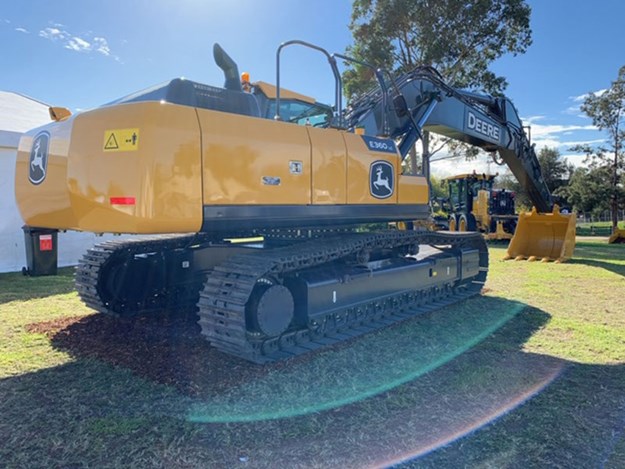 |
|
A healthy 600-litre fuel tank will ensure you get more than a good day’s work out of the E360 digger
|
Deere E360LC
First impressions count and on first look, the 36-tonne Deere did impress.
Track plates can be either 600mm or 800mm in width (optional), there’s an extra-large cabin and good vision from the operator’s seat in all directions. The spec sheet reads pretty darned good as well.
These new Aussie excavators will initially have the EU tier 2 stage John Deere Power Tech 6090 (9-litre) turbo charged diesel engine running a 238kW of power @ 1,900rpm.
The engine runs the tandem variable-displacement, electro hydraulic (EH)-controlled, axial-piston pumps developing 2 x 304 l/m (at 100 per cent efficiency).
The two-speed fully hydrostatic track drives can reach speeds of 5.2km/h at high speed and 2.9km/h at low speed but a healthy 600-litre fuel tank will ensure you get more than a good day’s work out of the E360 digger.
The extra strong and well-designed undercarriage/track frame carries 50 track shoes per side, two upper carrier rollers and nine track rollers (three guides) each side. That is a fair bit of track on the ground and if you wish to go wider you can always opt for the 800mm-wide track plates for those softer ground conditions you may be more familiar with.
You also can option the dipper arm length between 3.2 and 2.8 metres long, which means you can dig to a maximum 7.7m, cut at a maximum height of almost 10.5m and reach almost 11m.
However, the spec sheet on the E360LC states that it is possible to lift almost nine ton over front and over seven ton from the side of the machine. Just goes to prove that the stability and power of the machine is right up there with the best.
The visibility, seating, control positioning, screen size and simplistic dash layout were ultra-functional but the most eye-catching part was the generous size of the cabin.
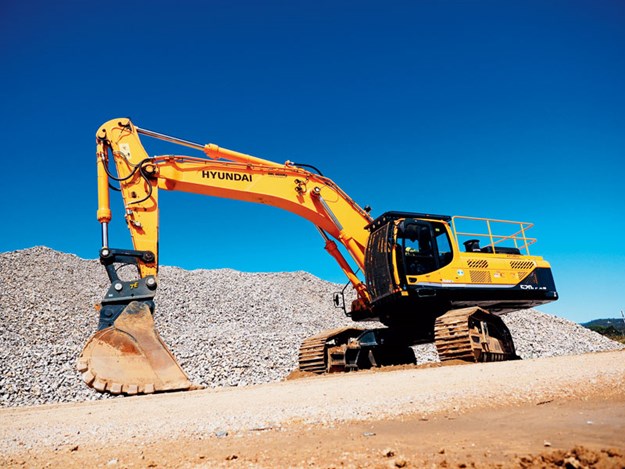 |
|
Comfort and functionality make this machine more than adequate for a long, hard day in the quarry
|
Hyundai R520LC-9
Sitting alone at the work face is the 51-tonne Hyundai R520-LC-9 excavator, running hard to extract and move some of the huge boulders using its big Furukawa F70 hydraulic rock breaker.
The Hyundai R520LC-9 runs a big Cummins QSM11 turbo-diesel engine pushing out a healthy 255kW (342hp). It delivers plenty of oil – 740 litres/min – to the hydraulic pumps, which is more than enough to run the big Furukawa F70 hydraulic rock-breaker.
The machine is fitted with a short stick, which is ideal for getting power to the ground and lifting those big rocks, but is a bugger to use when loading trucks. You tend to run out of reach on a regular basis and movements are made often. Again, another trade-off.
The long track frame, fitted with lifesaving track and roller guards, certainly is beneficial here. The track frame on the Hyundai is exceptionally strong, built with huge steel plate.
The cab of the Hyundai is quite spacious, but the operator’s vision is slightly impaired out the front due to the necessary rock guards. When you have serious money invested in the production machine however, you need to keep the cabin safe, and this is one of the many trade-offs encountered in our game.
The seating is well and truly up to scratch, the air-conditioning works beautifully, and the hydraulics operate smoothly – all of which help to make for a neat and tidy excavator.
A well-defined aftermarket two-way dashboard, reversing camera and operator-friendly joysticks make this machine more than adequate for a long, hard day in the quarry.
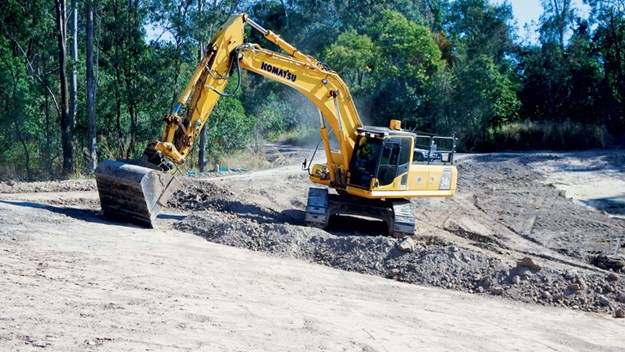 |
|
The excavator is ideal for final trim work
|
Komatsu PC300LC-8
Young Dan O’Flaherty, a 20-year-old operator from Dayboro, Queensland, who runs a 34-tonne Komatsu PC300LC-8 excavator for East Coast Mining Group.
The Komatsu has just over 1,500 hours on the clock but the reason I was interested in reviewing it was that the presentation and the setup of this final trim machine is almost perfect.
Komatsu providing ex-factory a number of features which previously would have been classified as optional extras, including a high-capacity automatic air-conditioner which creates a fully pressurised cabin, a 7-inch LCD colour monitor, a safety switch and alarm for the quick hitch integrated into the same circuit and six factory-fitted lights.
The high-visibility ROPS cabin (OPG Level 1 compliant) and the layout of the cabin and gauges are exceptional. Three factory-fitted mirrors are located left, right and rear, and are really well positioned to maximise visibility. This machine came supplied ex-dealer with safety handrails and rotating beacons already fitted.
Rounding out the feature list is Komatsu’s KOMTRAX Machine Satellite Tracking System.
I felt instantly at ease in the operator’s seat. The cabin felt wide and came complete with a fully reclining seat and backrest.
I thought the seating arrangement, the unimpeded view of the gauges, the GPS monitor, the external mirrors, the 7-inch monitor and the vision through all the windows were perfect
With its four modes of operation the machine handled everything I could throw at it.
The engine on the PC300LC-8 is a proven four-cylinder turbocharged and after-cooled Komatsu engine pushing out 184kW attached to a ‘HydrauMind’ hydraulic valve system developing a flow rate of 535 L/minute.
What this meant is that the excavator had all the power I needed as I shaped the batters on the sediment basin under construction. It was also well balanced.
Our love for 30-tonne excavators is second to none throughout the world, and with the PC300LC-8 Komatsu has once again came to the fore and delivered an exceptional, well-balanced and reliable excavator.
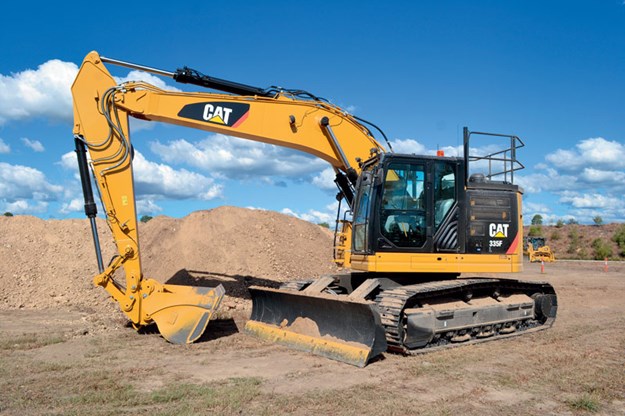 |
|
With the blade placed on the ground there is fantastic stability for digging and lifting for side, front or rear use
|
Caterpillar 335F L CR
The Cat 335F L CR is a compact radius excavator made for heavy work on congested job sites – and sports a very decent blade.
The first thing you will realise when getting into the operator’s seat of the Cat 335F L CR excavator is that this is a very large cabin.
A large monitor stares you right in the face. At first glance I thought you’d need to be a computer geek to conquer it, but it turned out to be quite simple.
Not all of the information can be sourced from the monitor. It has to be used in conjunction with the other control functions located on the right-hand dash. Cat has thought this one through and, believe me, it is quite impressive.
I decided to take the big girl on a trek up over the stockpile located within the demonstration zone. Two-speed travel mode is ample to get the excavator moving at a suitable speed, and when I put the blade in the ground before ascending the stockpile and cutting back to turtle mode I wondered just how much material it would push while climbing the 30-degree incline.
The Cat 335F handled the ‘climb and push’ with ease, as it did with the bulk handling trial I then put it through.
The hydraulics are very powerful and even when I cut the throttle way back to very low revs the operation of the bucket, dipper, slew and boom were very smooth and had no sign of intermittent hydraulic fade.
This machine comes with optional sticks with lengths of 8, 10 or 12 feet, which gives the Cat 335F excellent lifting capacity and digging power. With the blade placed on the ground there is fantastic stability for digging and lifting for side, front or rear use.
One small downside is that the view on the blade is very restricted. It is my opinion that the blade needs to be extended forward of its current position by between 150mm to 300mm to enable the operator to have better grade control.
However, Cat has not failed in delivering a set of big drive motors which have no problem in spinning the tracks and effortlessly push the rig with a full blade.
 |
|
The big Sumitomo SH330 LC digger has all the comforts equal to any of the competitors in the similar class
|
Sumitomo SH330 LC
As with all Japanese-built machines, the dash and cabin layout of the Sumitomo SH330 LC are all pretty predictable, with a few minor changes here and there depending on the model and make.
Auto-decelerate, turbo timer and a good-sized monitor with easy-to-sort functions are just some of the points worthy of note.
Vision is excellent but the rear cameras do come in handy due to the height of the engine cowling at the back of the cabin.
The big twin variable displacement axial piston hydraulic pumps deliver plenty of flow to run the big Rammer hammer. The Sumitomo SH330 handles it with ease and is quite well balanced when put to the test and, with the big 350-litre hydraulic tank, ensures there is enough oil to keep everything nice and cool.
The pump is fed by the big 198kW Isuzu turbo-diesel engine and, with a fuel tank of almost 600 litres, has enough to get you through the longest of shifts.
The engine is easy to access and the dip stick is placed perfectly for easy reading during pre-start checking. The heat shield over the turbo is a good thing for protecting the operator when accessing the engine bay for any other issues.
The long undercarriage is compulsory due to the weight of the Rammer 4099 hammer (3.75 tonnes) and helps take the bounce out of the operation of the machine while repositioning and travelling.
The big Sumitomo SH330 LC digger has all the comforts equal to any of the competitors in the similar class.
Seating and vision, well balanced, powerful, operator comfort and precise controls are some of the things that make the ‘Sumi’ a good choice.
Overall, and the harsh rocky conditions and work environment aside, this Sumitomo SH330 LC excavator and the Rammer 4099 hammer get a big thumbs up from me.
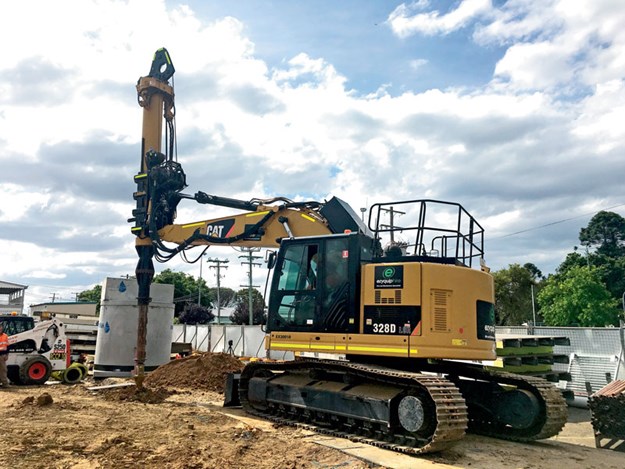 |
|
To keep up with the day’s long running you have a 400-litre fuel tank with 290 litres of hydraulic oil
|
Cat 328D LCR
Here was a very well-presented Cat 328D long-carriage, close-radius, bladed excavator with a Bay Shore LoDril attached to the boom for drilling piles.
Normally you would expect to have a bulky truck-mounted rig on site taking up much of the limited site area, requiring lots of turning and access room and needing to work to a strict pre-determined drilling plan due to its limited mobility.
This configuration was much more appealing. The Cat 328D fits snugly onto a float – no escorted wide-load permits here – and the permanently attached mast fits under the track frame for easy loading, transporting and unloading once onsite.
The Cat 328D LCR weighs in at about the 33-tonne mark and runs the Cat C7 Acert 204hp (152kW) turbo-diesel engine. An ECM (electronic control module) acts as the brains of the engine’s control system and responds quickly to operating variables to maximise engine efficiency.
Fully integrated sensors in the engine’s fuel, air, coolant and exhaust systems are stored by the ECM and relay information on conditions such as rpm, fuel consumption and diagnostics.
To keep up with the day’s long running you have a 400-litre fuel tank with 290 litres of hydraulic oil to ensure the hydraulic attachments have plenty of lubricant in reserve to keep temperatures down.
In the cab, the Cat 328D provides excellent in-front vision, has an extremely good layout, and has all the mod cons – such as tinted windows, aircon, full graphic monitor and reversing camera – required to make the day on the site a very pleasant one.
One in-cab addition on this earthmover is the ‘Intelli-Pile Monitor’, which is attached to the GPS and gives the operator control over the exacting positioning of the auger when drilling.
The close-radius design of the excavator ensures minimal amount of counterweight is hanging over the tracks and, although not zero swing, still provides the perfect balance for this operation with a mere 305mm counterweight overhang.
Overall, this is a perfect example of the advent of modern technology with continuing advancement of hydraulic attachments ensuring that excavators will not be going out of fashion any time soon.

